Curriculum of the Future: Development, Design, and Implementation
VerifiedAdded on 2021/04/16
|8
|2125
|133
Essay
AI Summary
This essay delves into the multifaceted aspects of future curriculum design, emphasizing the cyclical model of development, starting with needs analysis and progressing through planning, development, piloting, dissemination, implementation, and evaluation. Focusing on the Malaysian education system, the essay highlights collaborative curriculum formulation, content segmentation, and teaching methods. It explores various educational philosophies, including perennialism and essentialism, and their impact on curriculum design. The essay stresses the importance of creating responsible citizens and designing curricula that promote critical thinking, social awareness, and integrated learning. It also discusses evaluation methods like the Eisner and Connoisseurship model and emphasizes the need for educators to be competent and resourceful. The essay concludes by advocating for integrated curricula, student-centered learning, and the holistic development of students to prepare them for the future.
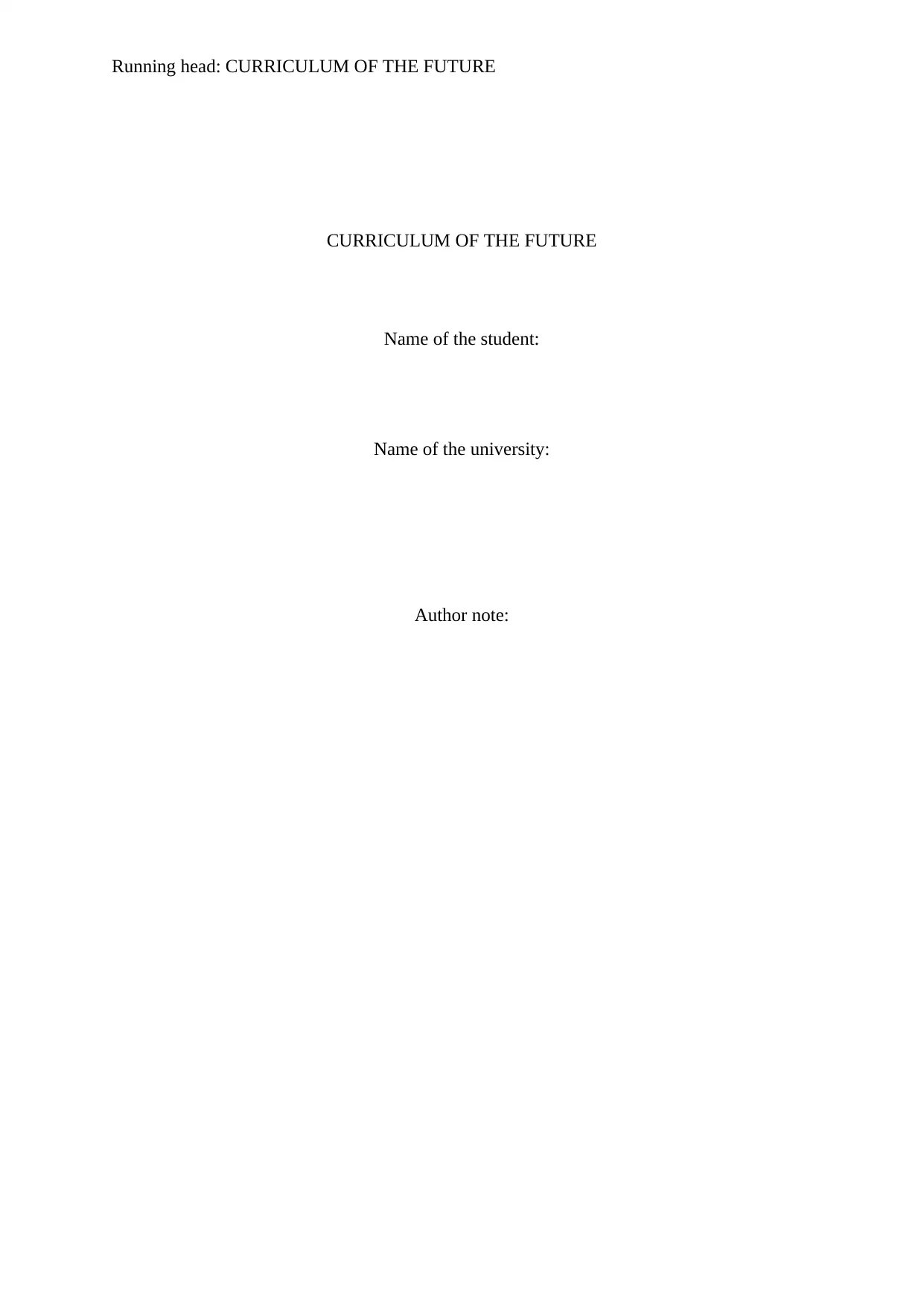
Running head: CURRICULUM OF THE FUTURE
CURRICULUM OF THE FUTURE
Name of the student:
Name of the university:
Author note:
CURRICULUM OF THE FUTURE
Name of the student:
Name of the university:
Author note:
Paraphrase This Document
Need a fresh take? Get an instant paraphrase of this document with our AI Paraphraser
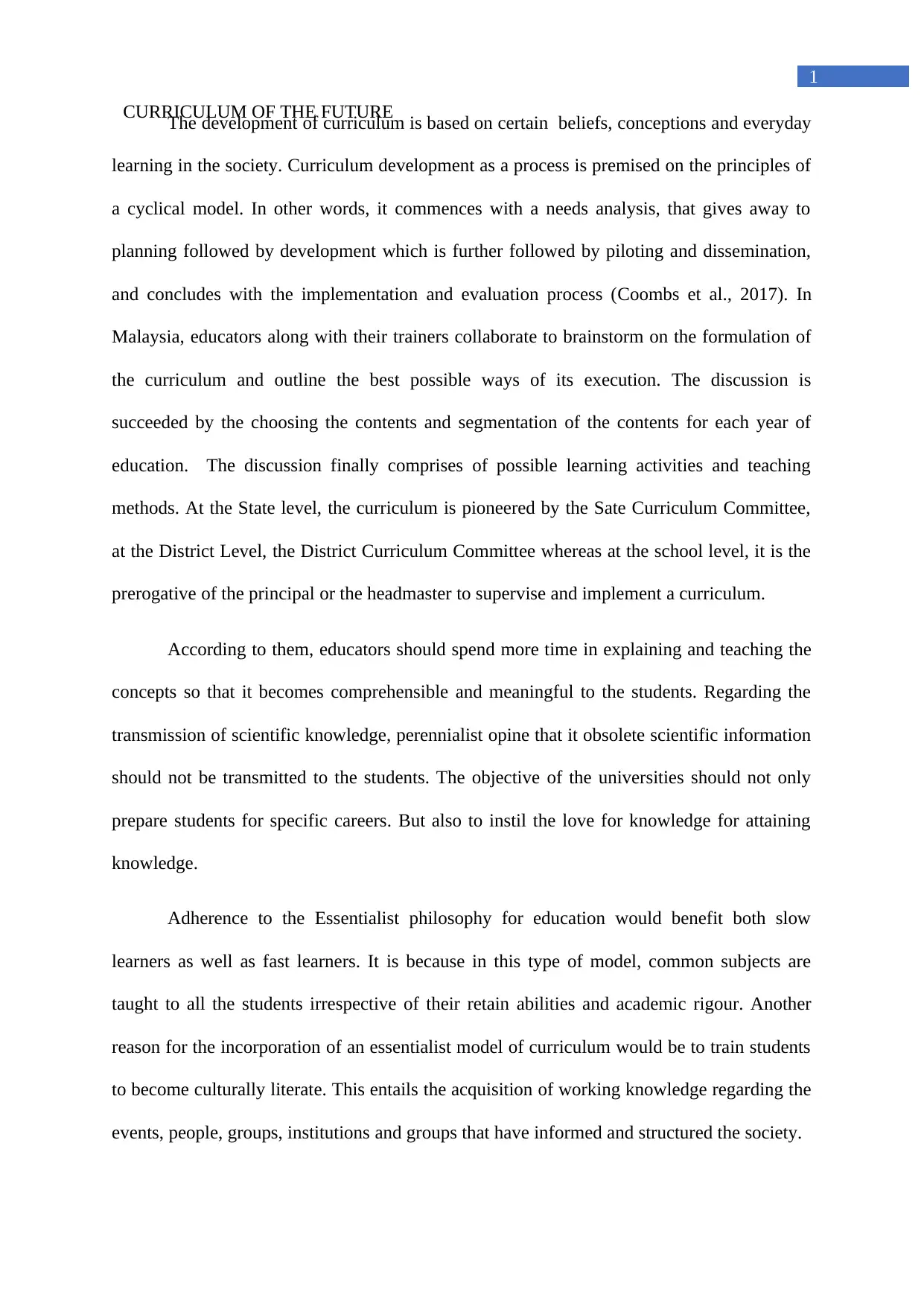
1
CURRICULUM OF THE FUTURE
The development of curriculum is based on certain beliefs, conceptions and everyday
learning in the society. Curriculum development as a process is premised on the principles of
a cyclical model. In other words, it commences with a needs analysis, that gives away to
planning followed by development which is further followed by piloting and dissemination,
and concludes with the implementation and evaluation process (Coombs et al., 2017). In
Malaysia, educators along with their trainers collaborate to brainstorm on the formulation of
the curriculum and outline the best possible ways of its execution. The discussion is
succeeded by the choosing the contents and segmentation of the contents for each year of
education. The discussion finally comprises of possible learning activities and teaching
methods. At the State level, the curriculum is pioneered by the Sate Curriculum Committee,
at the District Level, the District Curriculum Committee whereas at the school level, it is the
prerogative of the principal or the headmaster to supervise and implement a curriculum.
According to them, educators should spend more time in explaining and teaching the
concepts so that it becomes comprehensible and meaningful to the students. Regarding the
transmission of scientific knowledge, perennialist opine that it obsolete scientific information
should not be transmitted to the students. The objective of the universities should not only
prepare students for specific careers. But also to instil the love for knowledge for attaining
knowledge.
Adherence to the Essentialist philosophy for education would benefit both slow
learners as well as fast learners. It is because in this type of model, common subjects are
taught to all the students irrespective of their retain abilities and academic rigour. Another
reason for the incorporation of an essentialist model of curriculum would be to train students
to become culturally literate. This entails the acquisition of working knowledge regarding the
events, people, groups, institutions and groups that have informed and structured the society.
CURRICULUM OF THE FUTURE
The development of curriculum is based on certain beliefs, conceptions and everyday
learning in the society. Curriculum development as a process is premised on the principles of
a cyclical model. In other words, it commences with a needs analysis, that gives away to
planning followed by development which is further followed by piloting and dissemination,
and concludes with the implementation and evaluation process (Coombs et al., 2017). In
Malaysia, educators along with their trainers collaborate to brainstorm on the formulation of
the curriculum and outline the best possible ways of its execution. The discussion is
succeeded by the choosing the contents and segmentation of the contents for each year of
education. The discussion finally comprises of possible learning activities and teaching
methods. At the State level, the curriculum is pioneered by the Sate Curriculum Committee,
at the District Level, the District Curriculum Committee whereas at the school level, it is the
prerogative of the principal or the headmaster to supervise and implement a curriculum.
According to them, educators should spend more time in explaining and teaching the
concepts so that it becomes comprehensible and meaningful to the students. Regarding the
transmission of scientific knowledge, perennialist opine that it obsolete scientific information
should not be transmitted to the students. The objective of the universities should not only
prepare students for specific careers. But also to instil the love for knowledge for attaining
knowledge.
Adherence to the Essentialist philosophy for education would benefit both slow
learners as well as fast learners. It is because in this type of model, common subjects are
taught to all the students irrespective of their retain abilities and academic rigour. Another
reason for the incorporation of an essentialist model of curriculum would be to train students
to become culturally literate. This entails the acquisition of working knowledge regarding the
events, people, groups, institutions and groups that have informed and structured the society.
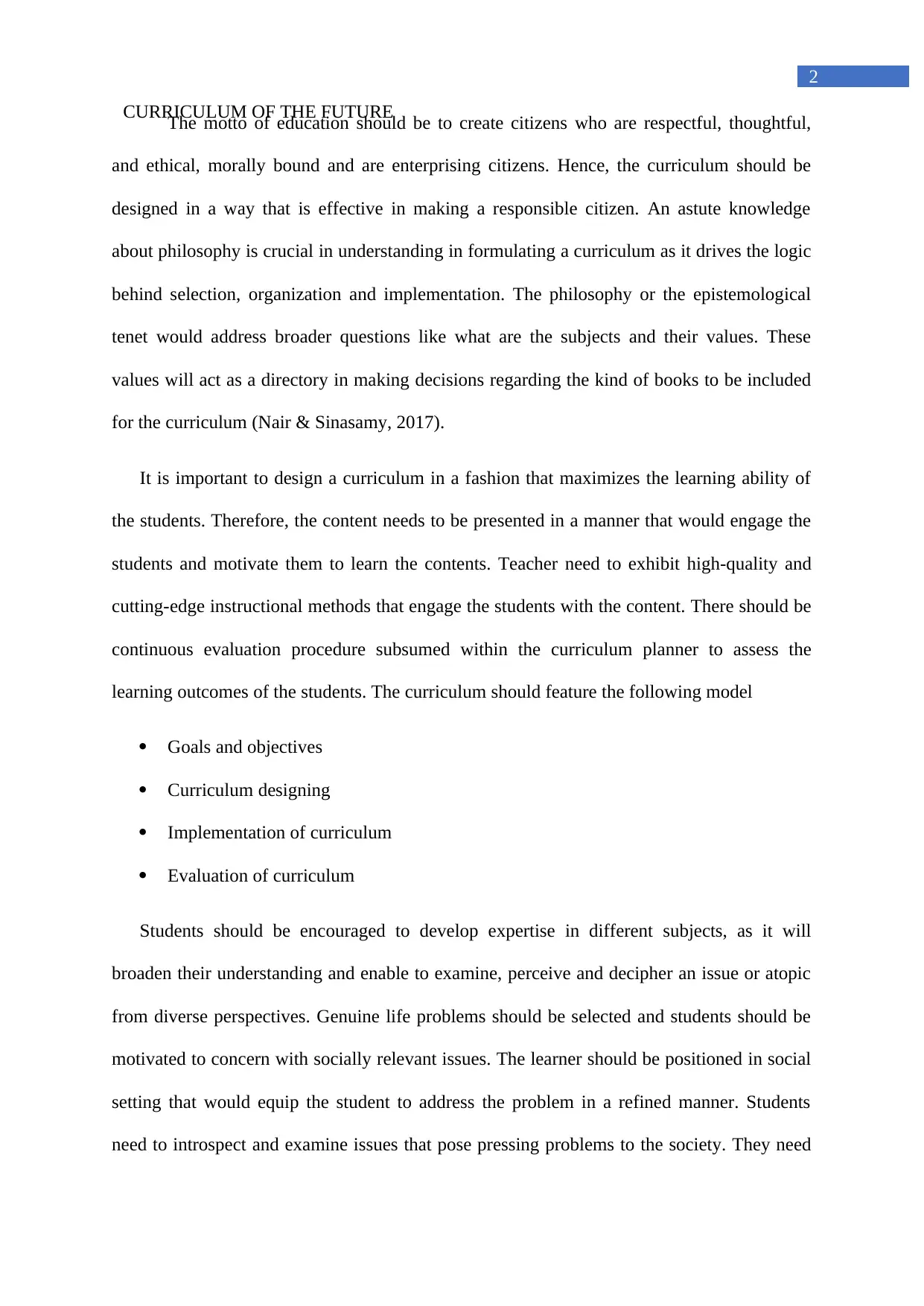
2
CURRICULUM OF THE FUTURE
The motto of education should be to create citizens who are respectful, thoughtful,
and ethical, morally bound and are enterprising citizens. Hence, the curriculum should be
designed in a way that is effective in making a responsible citizen. An astute knowledge
about philosophy is crucial in understanding in formulating a curriculum as it drives the logic
behind selection, organization and implementation. The philosophy or the epistemological
tenet would address broader questions like what are the subjects and their values. These
values will act as a directory in making decisions regarding the kind of books to be included
for the curriculum (Nair & Sinasamy, 2017).
It is important to design a curriculum in a fashion that maximizes the learning ability of
the students. Therefore, the content needs to be presented in a manner that would engage the
students and motivate them to learn the contents. Teacher need to exhibit high-quality and
cutting-edge instructional methods that engage the students with the content. There should be
continuous evaluation procedure subsumed within the curriculum planner to assess the
learning outcomes of the students. The curriculum should feature the following model
Goals and objectives
Curriculum designing
Implementation of curriculum
Evaluation of curriculum
Students should be encouraged to develop expertise in different subjects, as it will
broaden their understanding and enable to examine, perceive and decipher an issue or atopic
from diverse perspectives. Genuine life problems should be selected and students should be
motivated to concern with socially relevant issues. The learner should be positioned in social
setting that would equip the student to address the problem in a refined manner. Students
need to introspect and examine issues that pose pressing problems to the society. They need
CURRICULUM OF THE FUTURE
The motto of education should be to create citizens who are respectful, thoughtful,
and ethical, morally bound and are enterprising citizens. Hence, the curriculum should be
designed in a way that is effective in making a responsible citizen. An astute knowledge
about philosophy is crucial in understanding in formulating a curriculum as it drives the logic
behind selection, organization and implementation. The philosophy or the epistemological
tenet would address broader questions like what are the subjects and their values. These
values will act as a directory in making decisions regarding the kind of books to be included
for the curriculum (Nair & Sinasamy, 2017).
It is important to design a curriculum in a fashion that maximizes the learning ability of
the students. Therefore, the content needs to be presented in a manner that would engage the
students and motivate them to learn the contents. Teacher need to exhibit high-quality and
cutting-edge instructional methods that engage the students with the content. There should be
continuous evaluation procedure subsumed within the curriculum planner to assess the
learning outcomes of the students. The curriculum should feature the following model
Goals and objectives
Curriculum designing
Implementation of curriculum
Evaluation of curriculum
Students should be encouraged to develop expertise in different subjects, as it will
broaden their understanding and enable to examine, perceive and decipher an issue or atopic
from diverse perspectives. Genuine life problems should be selected and students should be
motivated to concern with socially relevant issues. The learner should be positioned in social
setting that would equip the student to address the problem in a refined manner. Students
need to introspect and examine issues that pose pressing problems to the society. They need
⊘ This is a preview!⊘
Do you want full access?
Subscribe today to unlock all pages.

Trusted by 1+ million students worldwide
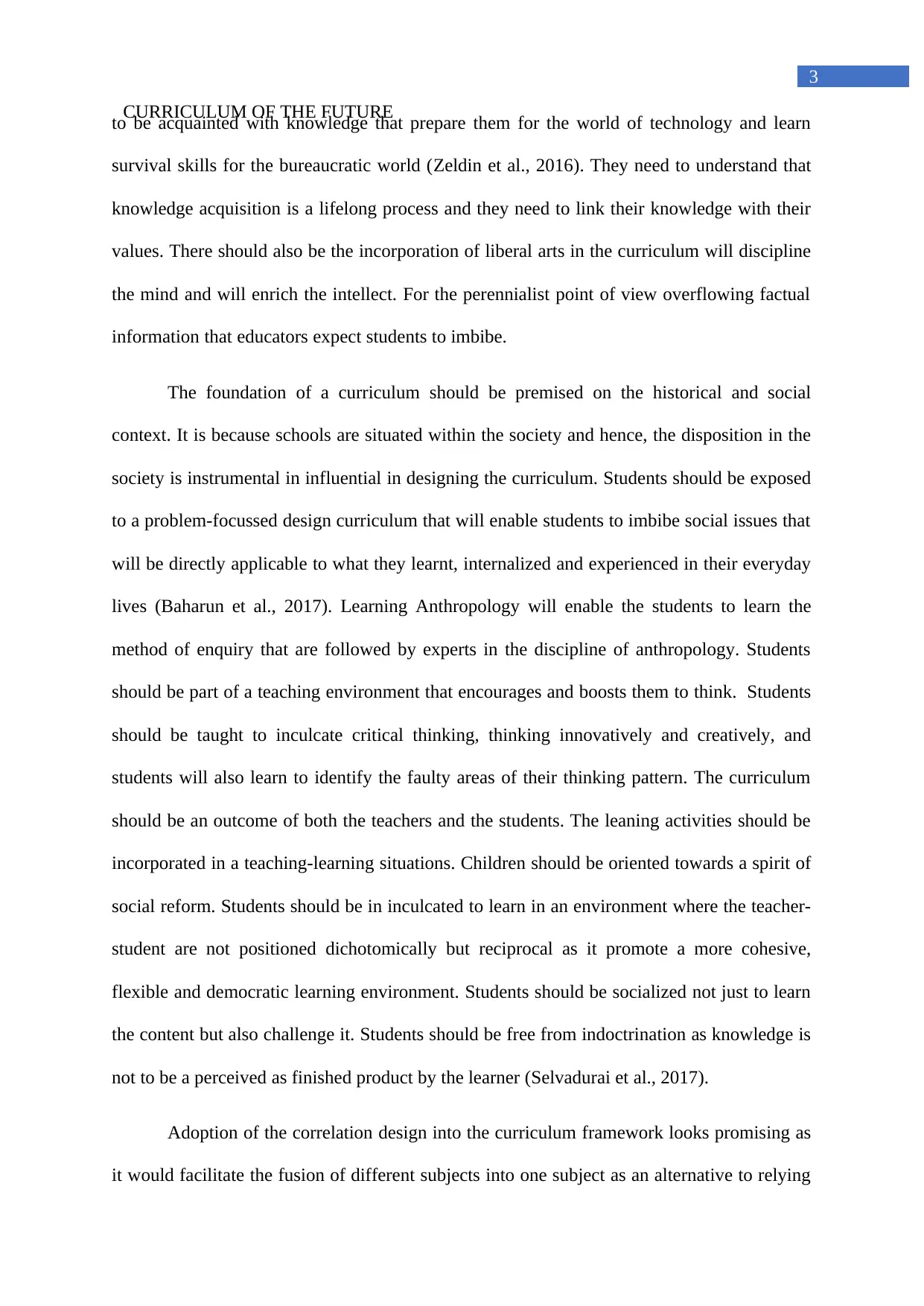
3
CURRICULUM OF THE FUTURE
to be acquainted with knowledge that prepare them for the world of technology and learn
survival skills for the bureaucratic world (Zeldin et al., 2016). They need to understand that
knowledge acquisition is a lifelong process and they need to link their knowledge with their
values. There should also be the incorporation of liberal arts in the curriculum will discipline
the mind and will enrich the intellect. For the perennialist point of view overflowing factual
information that educators expect students to imbibe.
The foundation of a curriculum should be premised on the historical and social
context. It is because schools are situated within the society and hence, the disposition in the
society is instrumental in influential in designing the curriculum. Students should be exposed
to a problem-focussed design curriculum that will enable students to imbibe social issues that
will be directly applicable to what they learnt, internalized and experienced in their everyday
lives (Baharun et al., 2017). Learning Anthropology will enable the students to learn the
method of enquiry that are followed by experts in the discipline of anthropology. Students
should be part of a teaching environment that encourages and boosts them to think. Students
should be taught to inculcate critical thinking, thinking innovatively and creatively, and
students will also learn to identify the faulty areas of their thinking pattern. The curriculum
should be an outcome of both the teachers and the students. The leaning activities should be
incorporated in a teaching-learning situations. Children should be oriented towards a spirit of
social reform. Students should be in inculcated to learn in an environment where the teacher-
student are not positioned dichotomically but reciprocal as it promote a more cohesive,
flexible and democratic learning environment. Students should be socialized not just to learn
the content but also challenge it. Students should be free from indoctrination as knowledge is
not to be a perceived as finished product by the learner (Selvadurai et al., 2017).
Adoption of the correlation design into the curriculum framework looks promising as
it would facilitate the fusion of different subjects into one subject as an alternative to relying
CURRICULUM OF THE FUTURE
to be acquainted with knowledge that prepare them for the world of technology and learn
survival skills for the bureaucratic world (Zeldin et al., 2016). They need to understand that
knowledge acquisition is a lifelong process and they need to link their knowledge with their
values. There should also be the incorporation of liberal arts in the curriculum will discipline
the mind and will enrich the intellect. For the perennialist point of view overflowing factual
information that educators expect students to imbibe.
The foundation of a curriculum should be premised on the historical and social
context. It is because schools are situated within the society and hence, the disposition in the
society is instrumental in influential in designing the curriculum. Students should be exposed
to a problem-focussed design curriculum that will enable students to imbibe social issues that
will be directly applicable to what they learnt, internalized and experienced in their everyday
lives (Baharun et al., 2017). Learning Anthropology will enable the students to learn the
method of enquiry that are followed by experts in the discipline of anthropology. Students
should be part of a teaching environment that encourages and boosts them to think. Students
should be taught to inculcate critical thinking, thinking innovatively and creatively, and
students will also learn to identify the faulty areas of their thinking pattern. The curriculum
should be an outcome of both the teachers and the students. The leaning activities should be
incorporated in a teaching-learning situations. Children should be oriented towards a spirit of
social reform. Students should be in inculcated to learn in an environment where the teacher-
student are not positioned dichotomically but reciprocal as it promote a more cohesive,
flexible and democratic learning environment. Students should be socialized not just to learn
the content but also challenge it. Students should be free from indoctrination as knowledge is
not to be a perceived as finished product by the learner (Selvadurai et al., 2017).
Adoption of the correlation design into the curriculum framework looks promising as
it would facilitate the fusion of different subjects into one subject as an alternative to relying
Paraphrase This Document
Need a fresh take? Get an instant paraphrase of this document with our AI Paraphraser
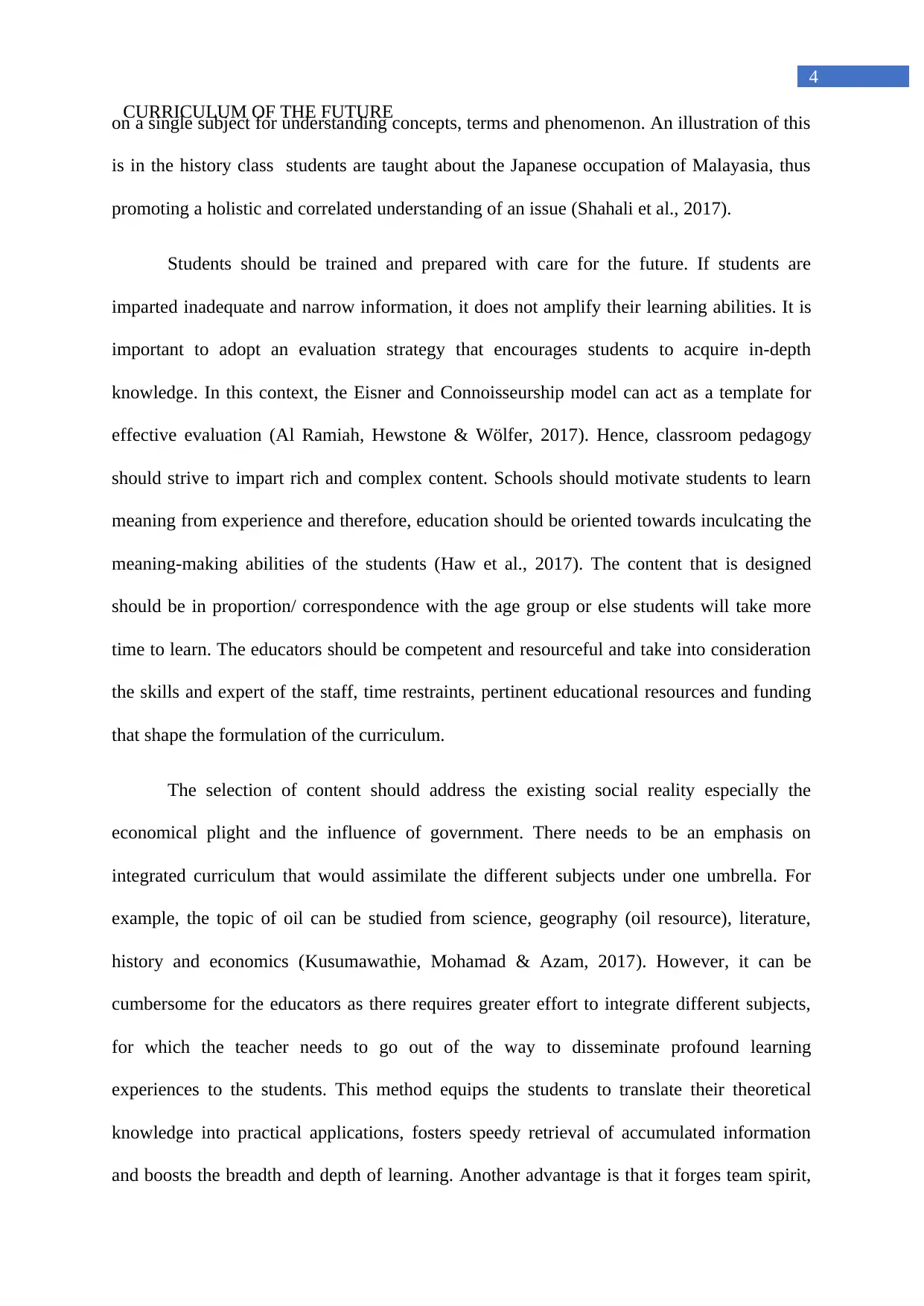
4
CURRICULUM OF THE FUTURE
on a single subject for understanding concepts, terms and phenomenon. An illustration of this
is in the history class students are taught about the Japanese occupation of Malayasia, thus
promoting a holistic and correlated understanding of an issue (Shahali et al., 2017).
Students should be trained and prepared with care for the future. If students are
imparted inadequate and narrow information, it does not amplify their learning abilities. It is
important to adopt an evaluation strategy that encourages students to acquire in-depth
knowledge. In this context, the Eisner and Connoisseurship model can act as a template for
effective evaluation (Al Ramiah, Hewstone & Wölfer, 2017). Hence, classroom pedagogy
should strive to impart rich and complex content. Schools should motivate students to learn
meaning from experience and therefore, education should be oriented towards inculcating the
meaning-making abilities of the students (Haw et al., 2017). The content that is designed
should be in proportion/ correspondence with the age group or else students will take more
time to learn. The educators should be competent and resourceful and take into consideration
the skills and expert of the staff, time restraints, pertinent educational resources and funding
that shape the formulation of the curriculum.
The selection of content should address the existing social reality especially the
economical plight and the influence of government. There needs to be an emphasis on
integrated curriculum that would assimilate the different subjects under one umbrella. For
example, the topic of oil can be studied from science, geography (oil resource), literature,
history and economics (Kusumawathie, Mohamad & Azam, 2017). However, it can be
cumbersome for the educators as there requires greater effort to integrate different subjects,
for which the teacher needs to go out of the way to disseminate profound learning
experiences to the students. This method equips the students to translate their theoretical
knowledge into practical applications, fosters speedy retrieval of accumulated information
and boosts the breadth and depth of learning. Another advantage is that it forges team spirit,
CURRICULUM OF THE FUTURE
on a single subject for understanding concepts, terms and phenomenon. An illustration of this
is in the history class students are taught about the Japanese occupation of Malayasia, thus
promoting a holistic and correlated understanding of an issue (Shahali et al., 2017).
Students should be trained and prepared with care for the future. If students are
imparted inadequate and narrow information, it does not amplify their learning abilities. It is
important to adopt an evaluation strategy that encourages students to acquire in-depth
knowledge. In this context, the Eisner and Connoisseurship model can act as a template for
effective evaluation (Al Ramiah, Hewstone & Wölfer, 2017). Hence, classroom pedagogy
should strive to impart rich and complex content. Schools should motivate students to learn
meaning from experience and therefore, education should be oriented towards inculcating the
meaning-making abilities of the students (Haw et al., 2017). The content that is designed
should be in proportion/ correspondence with the age group or else students will take more
time to learn. The educators should be competent and resourceful and take into consideration
the skills and expert of the staff, time restraints, pertinent educational resources and funding
that shape the formulation of the curriculum.
The selection of content should address the existing social reality especially the
economical plight and the influence of government. There needs to be an emphasis on
integrated curriculum that would assimilate the different subjects under one umbrella. For
example, the topic of oil can be studied from science, geography (oil resource), literature,
history and economics (Kusumawathie, Mohamad & Azam, 2017). However, it can be
cumbersome for the educators as there requires greater effort to integrate different subjects,
for which the teacher needs to go out of the way to disseminate profound learning
experiences to the students. This method equips the students to translate their theoretical
knowledge into practical applications, fosters speedy retrieval of accumulated information
and boosts the breadth and depth of learning. Another advantage is that it forges team spirit,
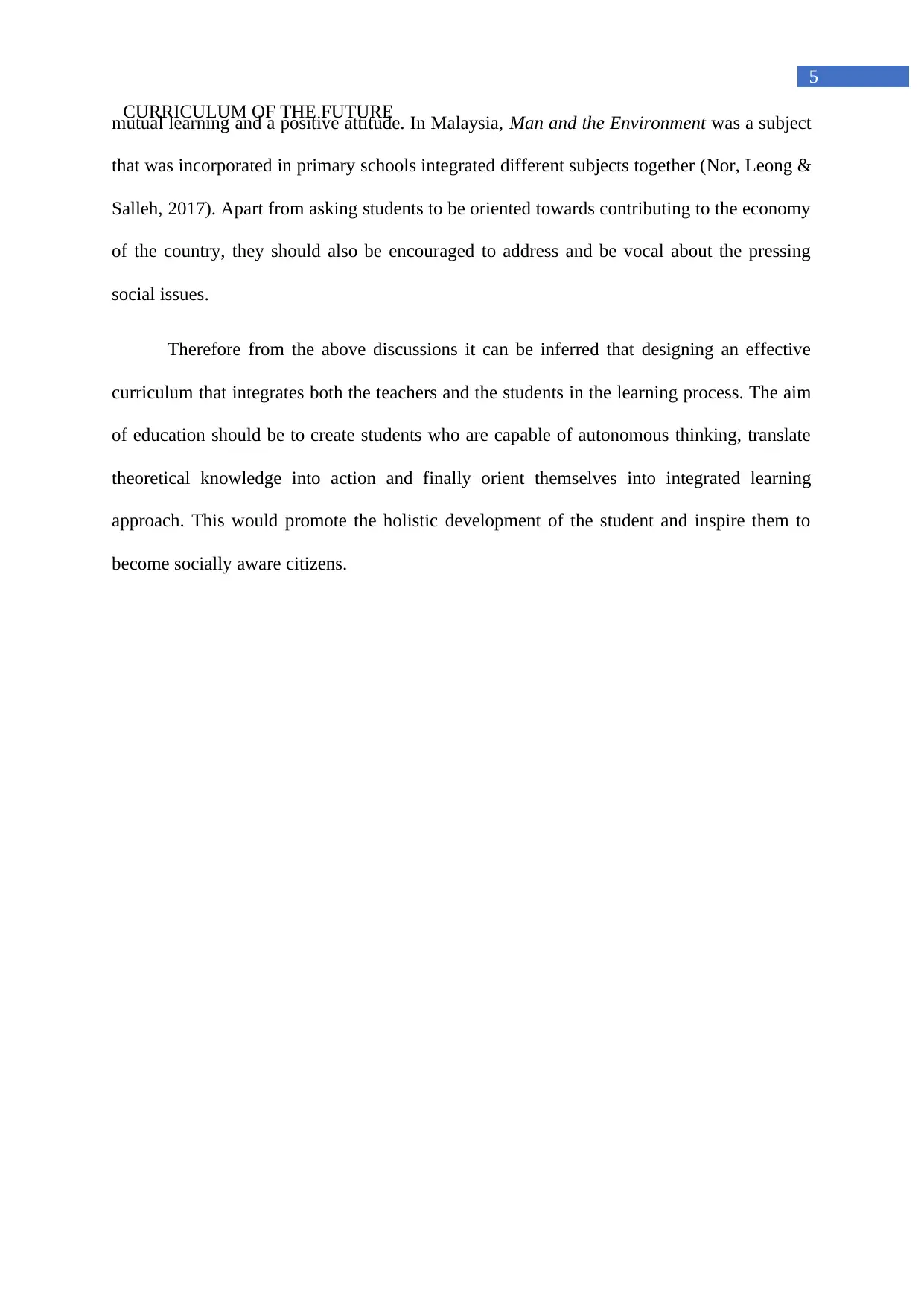
5
CURRICULUM OF THE FUTURE
mutual learning and a positive attitude. In Malaysia, Man and the Environment was a subject
that was incorporated in primary schools integrated different subjects together (Nor, Leong &
Salleh, 2017). Apart from asking students to be oriented towards contributing to the economy
of the country, they should also be encouraged to address and be vocal about the pressing
social issues.
Therefore from the above discussions it can be inferred that designing an effective
curriculum that integrates both the teachers and the students in the learning process. The aim
of education should be to create students who are capable of autonomous thinking, translate
theoretical knowledge into action and finally orient themselves into integrated learning
approach. This would promote the holistic development of the student and inspire them to
become socially aware citizens.
CURRICULUM OF THE FUTURE
mutual learning and a positive attitude. In Malaysia, Man and the Environment was a subject
that was incorporated in primary schools integrated different subjects together (Nor, Leong &
Salleh, 2017). Apart from asking students to be oriented towards contributing to the economy
of the country, they should also be encouraged to address and be vocal about the pressing
social issues.
Therefore from the above discussions it can be inferred that designing an effective
curriculum that integrates both the teachers and the students in the learning process. The aim
of education should be to create students who are capable of autonomous thinking, translate
theoretical knowledge into action and finally orient themselves into integrated learning
approach. This would promote the holistic development of the student and inspire them to
become socially aware citizens.
⊘ This is a preview!⊘
Do you want full access?
Subscribe today to unlock all pages.

Trusted by 1+ million students worldwide
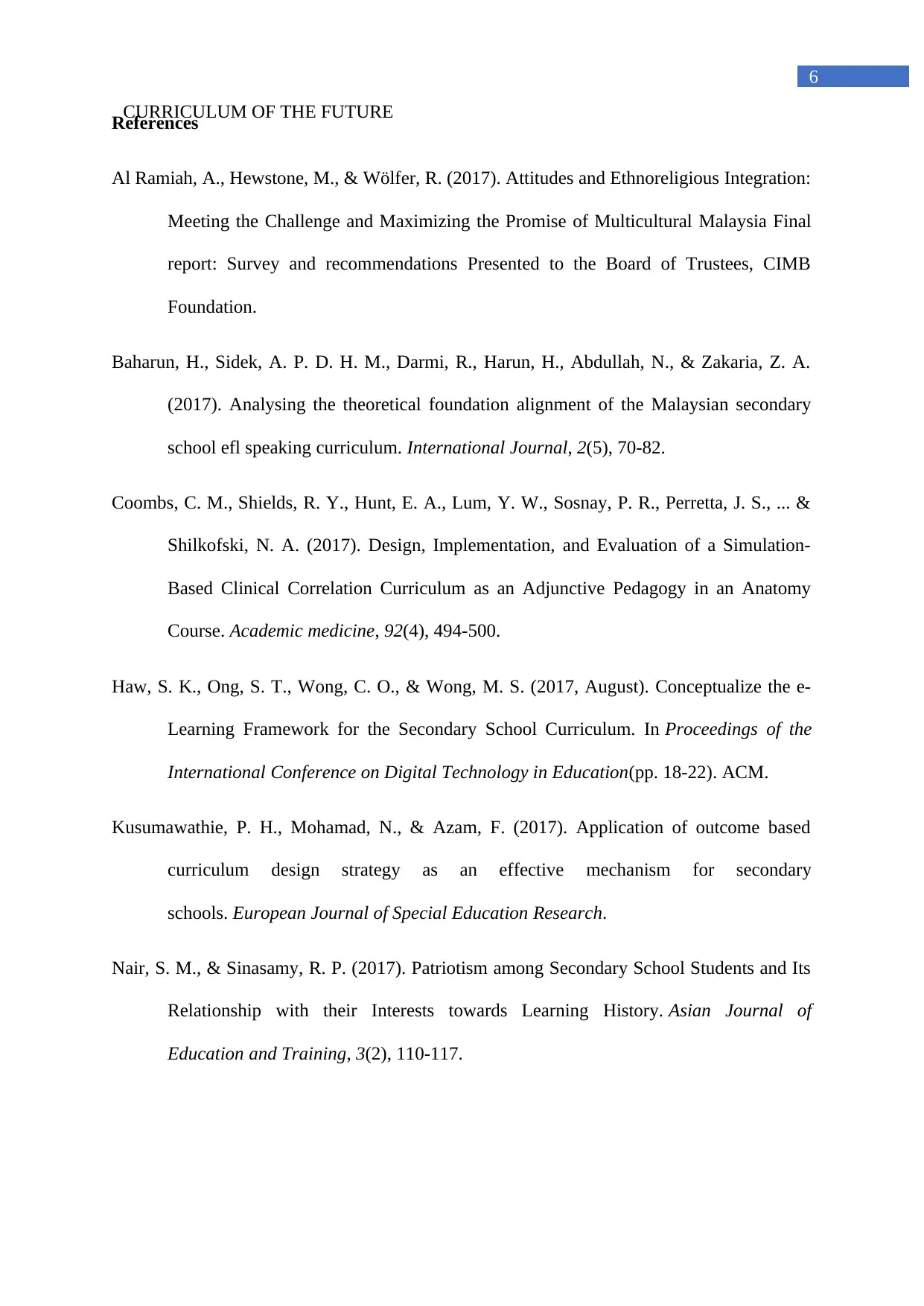
6
CURRICULUM OF THE FUTURE
References
Al Ramiah, A., Hewstone, M., & Wölfer, R. (2017). Attitudes and Ethnoreligious Integration:
Meeting the Challenge and Maximizing the Promise of Multicultural Malaysia Final
report: Survey and recommendations Presented to the Board of Trustees, CIMB
Foundation.
Baharun, H., Sidek, A. P. D. H. M., Darmi, R., Harun, H., Abdullah, N., & Zakaria, Z. A.
(2017). Analysing the theoretical foundation alignment of the Malaysian secondary
school efl speaking curriculum. International Journal, 2(5), 70-82.
Coombs, C. M., Shields, R. Y., Hunt, E. A., Lum, Y. W., Sosnay, P. R., Perretta, J. S., ... &
Shilkofski, N. A. (2017). Design, Implementation, and Evaluation of a Simulation-
Based Clinical Correlation Curriculum as an Adjunctive Pedagogy in an Anatomy
Course. Academic medicine, 92(4), 494-500.
Haw, S. K., Ong, S. T., Wong, C. O., & Wong, M. S. (2017, August). Conceptualize the e-
Learning Framework for the Secondary School Curriculum. In Proceedings of the
International Conference on Digital Technology in Education(pp. 18-22). ACM.
Kusumawathie, P. H., Mohamad, N., & Azam, F. (2017). Application of outcome based
curriculum design strategy as an effective mechanism for secondary
schools. European Journal of Special Education Research.
Nair, S. M., & Sinasamy, R. P. (2017). Patriotism among Secondary School Students and Its
Relationship with their Interests towards Learning History. Asian Journal of
Education and Training, 3(2), 110-117.
CURRICULUM OF THE FUTURE
References
Al Ramiah, A., Hewstone, M., & Wölfer, R. (2017). Attitudes and Ethnoreligious Integration:
Meeting the Challenge and Maximizing the Promise of Multicultural Malaysia Final
report: Survey and recommendations Presented to the Board of Trustees, CIMB
Foundation.
Baharun, H., Sidek, A. P. D. H. M., Darmi, R., Harun, H., Abdullah, N., & Zakaria, Z. A.
(2017). Analysing the theoretical foundation alignment of the Malaysian secondary
school efl speaking curriculum. International Journal, 2(5), 70-82.
Coombs, C. M., Shields, R. Y., Hunt, E. A., Lum, Y. W., Sosnay, P. R., Perretta, J. S., ... &
Shilkofski, N. A. (2017). Design, Implementation, and Evaluation of a Simulation-
Based Clinical Correlation Curriculum as an Adjunctive Pedagogy in an Anatomy
Course. Academic medicine, 92(4), 494-500.
Haw, S. K., Ong, S. T., Wong, C. O., & Wong, M. S. (2017, August). Conceptualize the e-
Learning Framework for the Secondary School Curriculum. In Proceedings of the
International Conference on Digital Technology in Education(pp. 18-22). ACM.
Kusumawathie, P. H., Mohamad, N., & Azam, F. (2017). Application of outcome based
curriculum design strategy as an effective mechanism for secondary
schools. European Journal of Special Education Research.
Nair, S. M., & Sinasamy, R. P. (2017). Patriotism among Secondary School Students and Its
Relationship with their Interests towards Learning History. Asian Journal of
Education and Training, 3(2), 110-117.
Paraphrase This Document
Need a fresh take? Get an instant paraphrase of this document with our AI Paraphraser
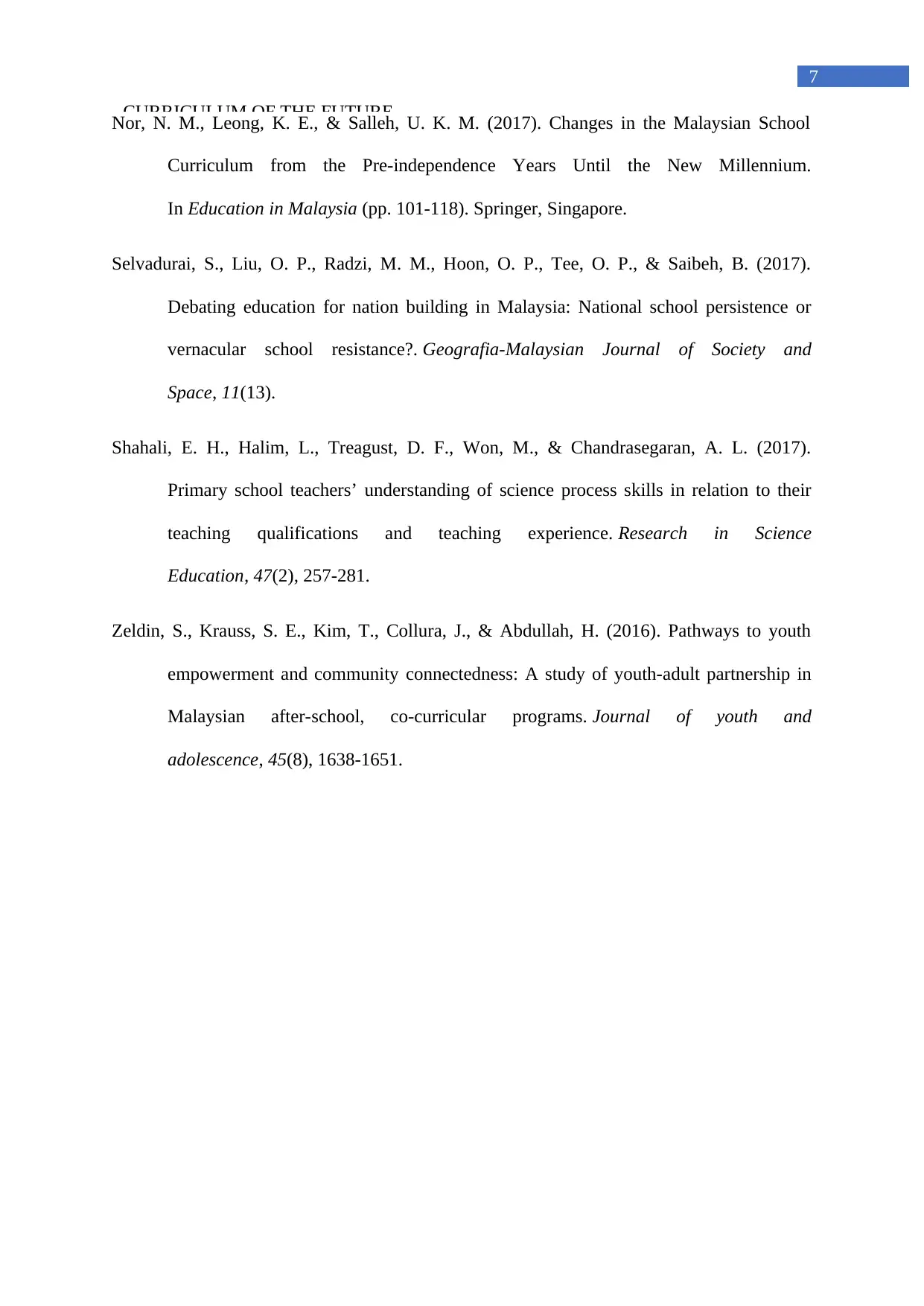
7
CURRICULUM OF THE FUTURE
Nor, N. M., Leong, K. E., & Salleh, U. K. M. (2017). Changes in the Malaysian School
Curriculum from the Pre-independence Years Until the New Millennium.
In Education in Malaysia (pp. 101-118). Springer, Singapore.
Selvadurai, S., Liu, O. P., Radzi, M. M., Hoon, O. P., Tee, O. P., & Saibeh, B. (2017).
Debating education for nation building in Malaysia: National school persistence or
vernacular school resistance?. Geografia-Malaysian Journal of Society and
Space, 11(13).
Shahali, E. H., Halim, L., Treagust, D. F., Won, M., & Chandrasegaran, A. L. (2017).
Primary school teachers’ understanding of science process skills in relation to their
teaching qualifications and teaching experience. Research in Science
Education, 47(2), 257-281.
Zeldin, S., Krauss, S. E., Kim, T., Collura, J., & Abdullah, H. (2016). Pathways to youth
empowerment and community connectedness: A study of youth-adult partnership in
Malaysian after-school, co-curricular programs. Journal of youth and
adolescence, 45(8), 1638-1651.
CURRICULUM OF THE FUTURE
Nor, N. M., Leong, K. E., & Salleh, U. K. M. (2017). Changes in the Malaysian School
Curriculum from the Pre-independence Years Until the New Millennium.
In Education in Malaysia (pp. 101-118). Springer, Singapore.
Selvadurai, S., Liu, O. P., Radzi, M. M., Hoon, O. P., Tee, O. P., & Saibeh, B. (2017).
Debating education for nation building in Malaysia: National school persistence or
vernacular school resistance?. Geografia-Malaysian Journal of Society and
Space, 11(13).
Shahali, E. H., Halim, L., Treagust, D. F., Won, M., & Chandrasegaran, A. L. (2017).
Primary school teachers’ understanding of science process skills in relation to their
teaching qualifications and teaching experience. Research in Science
Education, 47(2), 257-281.
Zeldin, S., Krauss, S. E., Kim, T., Collura, J., & Abdullah, H. (2016). Pathways to youth
empowerment and community connectedness: A study of youth-adult partnership in
Malaysian after-school, co-curricular programs. Journal of youth and
adolescence, 45(8), 1638-1651.
1 out of 8
Related Documents
Your All-in-One AI-Powered Toolkit for Academic Success.
+13062052269
info@desklib.com
Available 24*7 on WhatsApp / Email
![[object Object]](/_next/static/media/star-bottom.7253800d.svg)
Unlock your academic potential
Copyright © 2020–2025 A2Z Services. All Rights Reserved. Developed and managed by ZUCOL.





